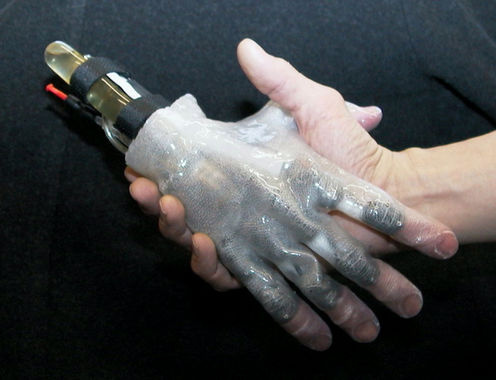2001 - Fluidhand 4
The Fluidhand 4 has 10 flexible bellows drives, each of which, when pressurized, angles an aluminum joint by 90 degrees. Stretching is achieved by suction of the drive medium and by additional elastic bands. Each long finger has two drives that are fluidically coupled to each other and each leads to a common control valve in the metacarpus. The thumb has two individually movable drives, each of which is actuated by a separate valve. The drive medium is water. This hand prosthesis operates hydraulically for the first time. A miniature pump draws the fluid from an elastic reservoir in the forearm and pumps it at up to 6 bar via the valve bank into the bellows drive chambers. The pump and valves are controlled by a microprocessor in the hand, and the prosthesis wearer gives the control commands via myoelectric sensors.
The skeletal structure of the prosthesis is made entirely of aluminum. The long fingers are flexibly mounted in the base in the direction of abduction. The unique combination of flexible fluid actuators and a mobile miniature hydraulic system in a myoelectrically controlled hand prosthesis opens up new possibilities in prosthetic fitting. The mechanical properties of the drives are already soft and flexible, making them ideal for adaptive grasping analogous to the human hand. Since the internal pressure is also distributed evenly in a hydraulic system, an ideal form fit to gripped objects is achieved. The grip thus adapts to an object independently and creates a maximally large contact surface, with the result that only very little grasping force is required to keep an object extraordinarily stable. The use of a hydraulic system has another advantage, which has a particularly positive effect on the mobility and weight of a prosthesis. The flexible fluid actuators are in themselves very small and lightweight drives. In the hydraulic pump, the electrical energy of the prosthesis battery is converted into kinetic energy. Only one pump is needed for the entire prosthesis system. The pump is the heaviest system component, but it can be positioned anywhere on the prosthesis because it is only connected to the valve bank and the drives via a flexible pressure hose. For optimal weight distribution in the prosthesis, the pump is placed as proximally to the arm as possible. Since all joints of my prosthesis are usually never moved at the same time, the pump size can be sized for a smaller number of drives. The grip selection is made using a reduced Morse code. A distinction is made between a long and a short myoelectric signal, with two consecutive signals considered at a time. User-defined settings as well as grip training are performed via a Bluetooth-connected pocket computer (precursor to the smartphone). The CFRP stem (Frühauf Handprothetik) and the lifelike silicone cosmetic (Pohlig Orthopädietechnik) create for the first time the combination of a multiarticulating functional hand and a habitus prosthesis.















